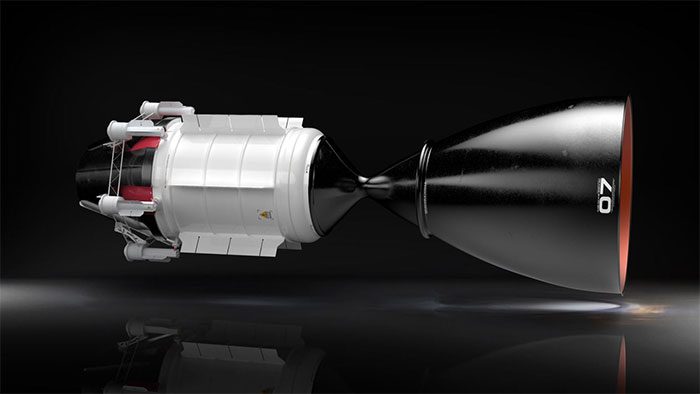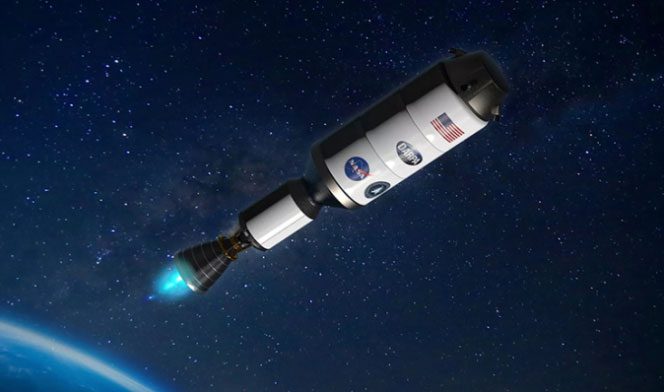In a statement on January 24, NASA Administrator Bill Nelson announced that with the help of this new rocket, astronauts could move to and from deep space faster than ever before, a crucial capability in preparation for Mars landing missions.
NASA has contracted Lockheed Martin to design, build, and test a nuclear-powered rocket for space travel. This technology could reduce the travel time for a crewed mission to Mars from the current minimum of 7 months to just 45 days.

Safe nuclear technology provides advanced nuclear thermal engine design for NASA. (Illustration: Engadget).
According to Popular Mechanics, NASA plans to utilize nuclear energy in an effort to reduce the time it takes to accomplish a crewed trip to Mars. This latest plan involves NASA reviving research on 70-year-old nuclear thermal technology and collaborating with contractors to begin testing nuclear-powered rockets in space shortly after 2027.
NASA and the U.S. Department of Defense’s Advanced Research Projects Agency (DARPA) have contracted Lockheed Martin to design, build, and test nuclear thermal rocket technology for a shorter, faster journey to the Red Planet. The rocket in this DRACO project is also expected to operate with double the efficiency of conventional chemical rockets, combining fuel and oxidizer to generate combustion energy.
Pam Melroy, NASA’s Deputy Administrator, stated in a release: “Collaborating with DARPA and companies in the commercial space industry will allow us to accelerate the development of the technology we need to get humans to Mars.” She emphasized, “This demonstration will be a significant step in meeting our goals of sending crews deeper into space, from the Moon to Mars.”
Lockheed Martin will lead the design, integration, and testing of the spacecraft in a project worth approximately $500 million, while BWX Technologies will design and manufacture the nuclear fission reactor to power the engine.
Tabitha Dodson, DARPA’s program director for the project, stated in a release that the DRACO project “aims to provide the nation with superior propulsion capabilities.”
Nuclear thermal rockets can achieve high thrust—similar to chemical propulsion—but with three times the efficiency. This means that instead of taking a minimum of 7 months to reach Mars as it does now, a nuclear-powered trip would take only 45 days. Moreover, reaching Mars in 45 days is not the only benefit, as NASA is also looking for a more efficient connection between Earth and the Moon.
Kirk Shireman, Vice President of Lunar Exploration at Lockheed Martin, said at a press conference: “For our country, for humanity to explore deeper into space, we need propulsion changes that are more efficient. Higher thrust is incredibly important. And I think we are at the cusp of that.”

Simulation of a rocket using nuclear propulsion. (Image: DARPA).
NASA stated that nuclear thermal rockets could be three times or more efficient than conventional chemical propulsion engines and would help reduce transportation time.
The new DRACO program aims to build on that initial research but with a new fuel option to alleviate logistical challenges. Using high-density, low-enriched uranium fuel, fission-based reactors can split atoms, heat liquid hydrogen, and shoot that high-temperature gas through the engine nozzle to create the necessary thrust.
The higher efficiency from nuclear thermal rockets not only helps reduce transportation time but also decreases risks for astronauts and cuts down on payload demands for the entire system.
According to Live Science, one challenge that remains unsolved is the need to heat hydrogen to over 2,400 degrees Celsius while simultaneously keeping it at minus 215 degrees Celsius. Dodson noted: “This is both a demonstration of storing cryogenic liquid hydrogen in orbit and a demo of the nuclear thermal rocket.”
In the anticipated test launch in 2027, the reactor of the engine will shut down for safety reasons until the rocket reaches its designated orbit. The U.S. Space Force will provide the launch vehicle to send the test craft into space.
The initial test of DRACO is planned to take the vehicle at least 696 km and no more than 1,984 km into space. It will not be maneuvered but will allow the vehicle’s reactor to use the new fuel and collect data along the way. According to Space News, with plans to store liquid hydrogen for two months on board, crews could also test refueling capabilities in space.
According to Live Science, Shireman told reporters: “We will put these things together, we will conduct this demonstration, gather a lot of great data, and we really believe this will open a new era for America, for humanity, to support our space exploration missions.”





















































